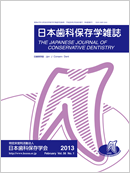Volume 56, Issue 5
Displaying 1-9 of 9 articles from this issue
- |<
- <
- 1
- >
- >|
Review
-
Article type: Review
2013 Volume 56 Issue 5 Pages 401-406
Published: October 31, 2013
Released on J-STAGE: April 28, 2017
Download PDF (13805K)
Original Articles
-
Article type: Original Articles
2013 Volume 56 Issue 5 Pages 407-414
Published: October 31, 2013
Released on J-STAGE: April 28, 2017
Download PDF (6025K) -
Article type: Origiinal Articles
2013 Volume 56 Issue 5 Pages 415-422
Published: October 31, 2013
Released on J-STAGE: April 28, 2017
Download PDF (8571K) -
Article type: Original Articles
2013 Volume 56 Issue 5 Pages 423-430
Published: October 31, 2013
Released on J-STAGE: April 28, 2017
Download PDF (14813K) -
Article type: Original Articles
2013 Volume 56 Issue 5 Pages 431-441
Published: October 31, 2013
Released on J-STAGE: April 28, 2017
Download PDF (4978K) -
Article type: Original Articles
2013 Volume 56 Issue 5 Pages 442-453
Published: October 31, 2013
Released on J-STAGE: April 28, 2017
Download PDF (1485K) -
Article type: Original Articles
2013 Volume 56 Issue 5 Pages 454-460
Published: October 31, 2013
Released on J-STAGE: April 28, 2017
Download PDF (9127K) -
Article type: Original Articles
2013 Volume 56 Issue 5 Pages 461-467
Published: October 31, 2013
Released on J-STAGE: April 28, 2017
Download PDF (3169K) -
Article type: Original Articles
2013 Volume 56 Issue 5 Pages 468-476
Published: October 31, 2013
Released on J-STAGE: April 28, 2017
Download PDF (25269K)
- |<
- <
- 1
- >
- >|
